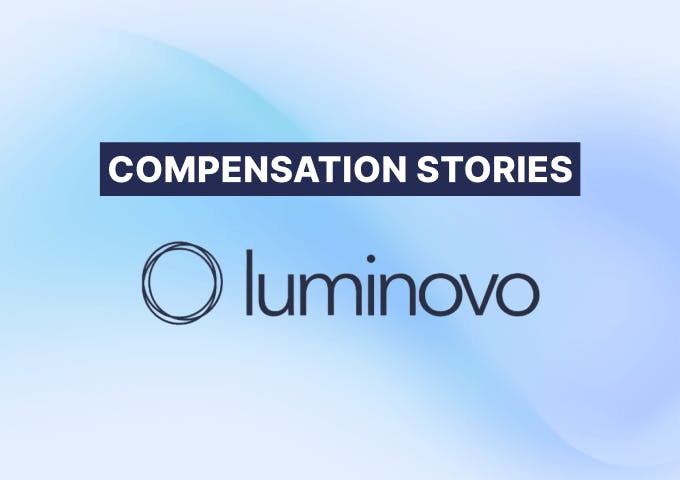🏢 Company name: Luminovo
🏭 Industry: AI Tech
🚀 Founded: 2017
👥 Headcount: ~70
🌍 HQ location: Remote-first (35 locations, 25 nationalities) with HQ office in Munich
💸 Compensation approach: Market-aligned, location-based, performance-based, transparent approach
Electronics supply chain platform, Luminovo, was founded in 2017 by Sebastian Schaal and Timon Ruban.
The founders have been bullish on company culture from the beginning – with foundational principles like performance-based hiring and cultivating psychological safety within the team having been well-documented over the years. In the early days, as is the case in many early-stage startups, they also owned compensation decisions.
More recently, as the team began to grow more quickly, the need to formally define the company’s approach to compensation, and how it fits alongside values and culture, became more and more pressing.
Hannah Reif – at the time Founders’ Associate, now People Lead – took on the project of formulating Luminovo’s compensation strategy and putting structures into place that would enable consistent compensation decisions as the team grew.
For this instalment of our ‘compensation stories’ series, we spoke to Hannah to find out how she approached the project, and get a behind-the-scenes glimpse at how compensation works at Luminovo today.
Interested in more compensation strategy examples? Subscribe to our monthly newsletter to stay up-to-date with the latest.
Luminovo’s values, culture, and compensation philosophy
How compensation decisions are made is heavily influenced by a company’s values, culture, working practices, and business goals – and the importance of this tailored approach is clear from Luminovo’s story.
Company culture at Luminovo: core operating principles
At Luminovo, there are two operating principles that guide how the team works: putting people first and building great things.
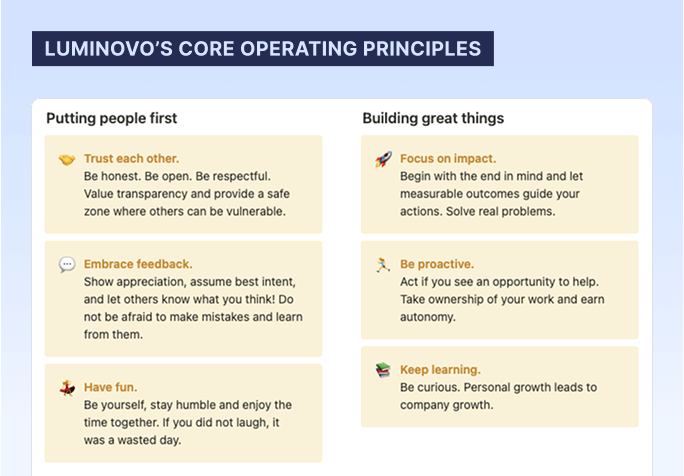
These operating principles are embedded throughout Luminovo's culture and ways of working, from how they hire to how they develop their team members.
In terms of ‘putting people first’, one particularly notable aspect of Luminovo's culture is their focus on psychological safety – cultivating a work environment where all team members feel safe to take risks.
In his blog on the subject, Founder Timon Fuban explains that psychological safety is a vital enabler for effective working and for retaining top employees, citing research by Google too.
“Individuals on teams with higher psychological safety are less likely to leave Google, they’re more likely to harness the power of diverse ideas from their teammates, they bring in more revenue, and they’re rated as effective twice as often by executives.”
Luminovo builds psychological safety through practices such as:
- Building shared understanding through communications – explanations of the concept are included in onboarding for all team members and the concept is referenced regularly in internal communications
- A culture of continuous feedback, where all team members are encouraged to give and readily receive feedback in a direct manner – with guidance on what ‘good feedback’ looks like too
- Living it through actions – managers admitting when they're wrong to reflect the desired behaviour, conducting post-mortems on failures, and encouraging feedback during 1:1s.
When it comes to ‘building great things’, another foundational element of Luminovo's culture is their performance-based hiring approach, which supports the development of a high-performing, innovative team.
Instead of focusing on requirements like years of experience or specific degree qualifications, they emphasise the skillset that Luminovo needs for a role and the responsibilities that will be expected, to ensure they can find the best-fit candidate.
In his blog on the subject, co-founder Timon Ruban gives the example of hiring for a Software Engineer role. Instead of a job description listing ‘good communicator with proficient Python programming skills and a Master’s degree in Machine Learning’, Luminovo might instead list ‘implement and tune state-of-the-art ML models to get the best possible results given a dataset and metric to optimise’.
Framing roles in this way also helps high-performing candidates to evaluate how the role aligns with their personal ‘opportunity gap’ i.e. whether the role will help them progress their career in the direction they want to, with the right stretch projects and growth opportunities.
"We need to hire and retain top talent. It is the single most important factor underlying all of our (potential) success. To do this consistently and to avoid hiring mediocre team members is the goal of the performance-based hiring process."

Co-founder of Luminovo
How do those principles manifest in Luminovo’s compensation approach?
Hannah used these cultural principles to inform Luminovo's overall compensation philosophy, in two key ways.
Firstly, the focus on high talent density and building a high-performing, innovation focused team leads to a compensation approach that is:
- Fair and competitive to secure high performers – with salaries benchmarked at or above market rates
- Inclusive of competitive equity options, so employees benefit from company success
- Inclusive of benefits like flexible working and childcare support
- Structured to avoid inconsistencies and pay equity issues – with sub levels for performance and progression, and no salary negotiation for new hires
- Location-based to maintain competitiveness in the context of a remote-first team.
Secondly, the company’s commitment to openness and psychological safety is reflected in:
- A transparently communicated compensation approach shared internally, to ensure employees understand how decisions are made
- A clear level framework with defined expectations for each role to support progression conversations.
Let’s take a closer look at how Luminovo’s compensation structure actually works.
“Defining our compensation philosophy based on our core operating principles ensures that every individual employee’s compensation package is derived from the same set of core values and criteria, for consistency and equity.”

People Lead at Luminovo
Luminovo’s level framework
Job levelling at Luminovo centres around the question: “How much business impact does the Luminerd create?”
Employees are leveled during hiring based on their skillset, capabilities, impact, and scope of work.
Luminovo has eight job levels in total (and three sub-levels within each level, as we’ll see in the next section), with some overlap within this between Individual Contributor (IC) and Manager (M) levels:
- L1 (IC) – mostly operational decisions
- L2 (IC) – more tactical than L1
- L3 (IC/M) – focused on strategy not operations
- L4 (IC/M) – budget responsibility for a department
- L5(IC/M) – the highest level of seniority
“For now, we wanted a level framework that isn’t too bloated. We’re still a small team and most of our employees are in the level 1-3 range, so we don’t need additional complexity yet – but we’ll of course look at increase granularity as we grow.”

People Lead at Luminovo
Detailed descriptions of the responsibilities and impact expected at each level are outlined within Luminovo’s Candidate Handbook to ensure strong employee understanding.
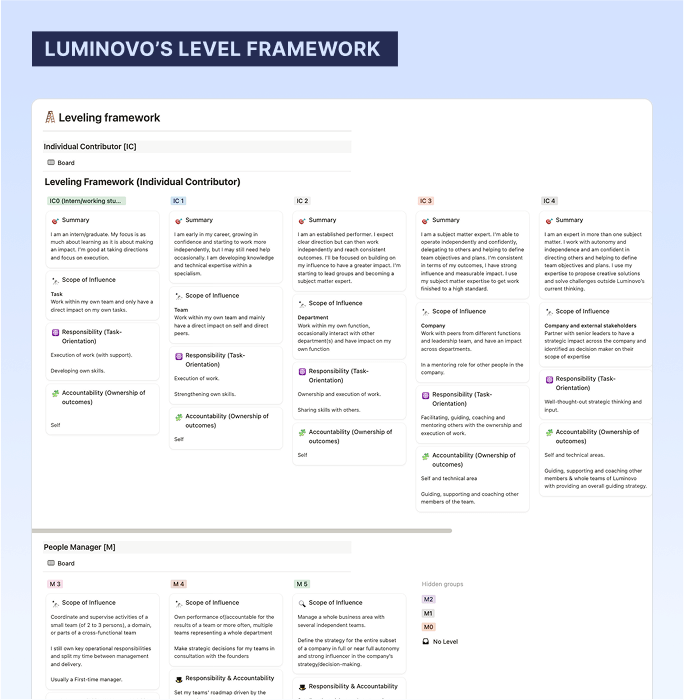
Employees can choose between the Individual Contributor (IC) or Manager track, but the company is clear that one is not superior to the other.
Rather, IC growth is focused on technical expertise and manager growth centres on leading people and taking responsibility for their work – different pathways, but equally valuable.
“Management should not be seen as a promotion, but a career decision. Different people will naturally fit or prefer different tracks based on personal motivations and preferences."
Career progression at Luminovo
There are three sub-levels within each job level at Luminovo, which are used to denote performance and progression within that level.
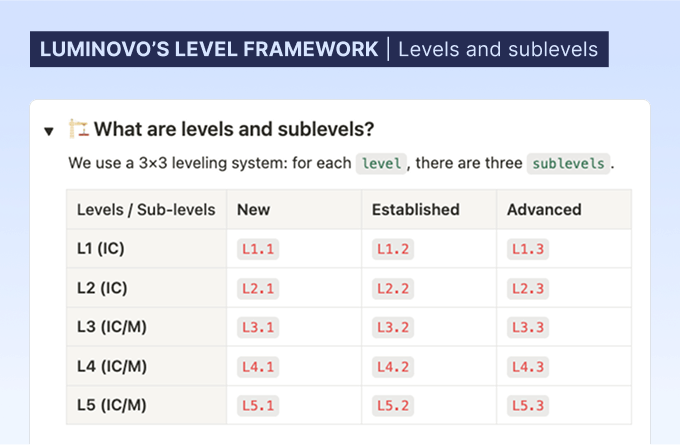
The sub levels are differentiated as follows:
- .1 new: meets 75% of the expectations for their level
- .2 established: meets 100% of the expectations for their level
- .3 advanced: meets 125% of the expectations for their level – and therefore 25% of the next level.
With more details outlined in the candidate handbook, as below.
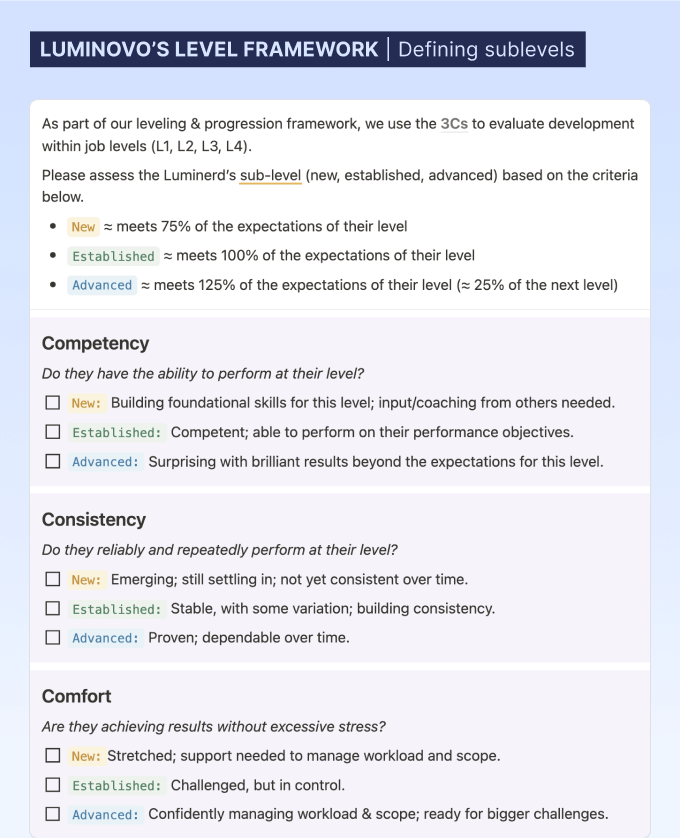
Each department then builds their own detailed progression framework with specific descriptions of the skills and capabilities required at each level and sublevel – like this example for the marketing team.
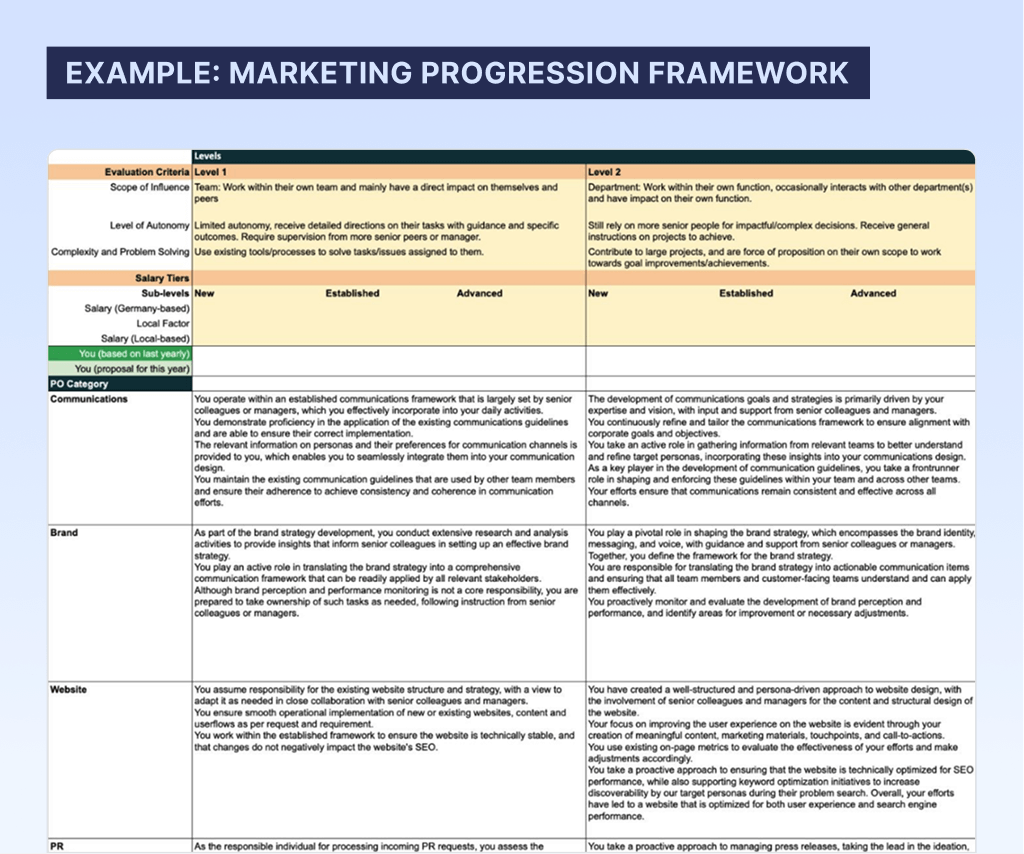
Employees at the same level and sublevel within a role are paid equally at Luminovo (though differences in working location may lead to variances) – with no salary negotiation allowed for new hires or within performance-related conversations to maintain consistency and internal pay equity.
This means that performance directly relates to pay progression: as employees grow and excel in their roles, they move up to the next sublevel or level, and this results in a pay increase – there’s no confusion or lack of clarity, meaning employees are able to focus on delivering and developing instead of worrying about increasing their pay.
"Structure has been key for clarity and efficiency. From my own perspective, I don’t have the capacity to look after compensation decisions for our entire team. If I can put the principles in place and equip managers to handle new hire offers and progression conversations then it’s much more efficient.”

People Lead at Luminovo
Luminovo’s total rewards structure
At Luminovo, total compensation = base salary + equity + benefits (+ OTE for some commercial roles).
Base salaries at Luminovo
In line with their focus on high talent density, Luminovo takes a market-based approach to salaries.
Real-time salary benchmarking data from Ravio is used to understand competitive compensation for each role and level (alongside other data sources for verification).
“Staying competitive is easier than ever with the real-time data and benchmarking tools available today. My tool of choice is Ravio because of the superior data quality.”

People Lead at Luminovo
Each role then has a set of ‘salary tiers’ which define how pay progression works, in alignment with Luminovo’s level and sublevels structure.
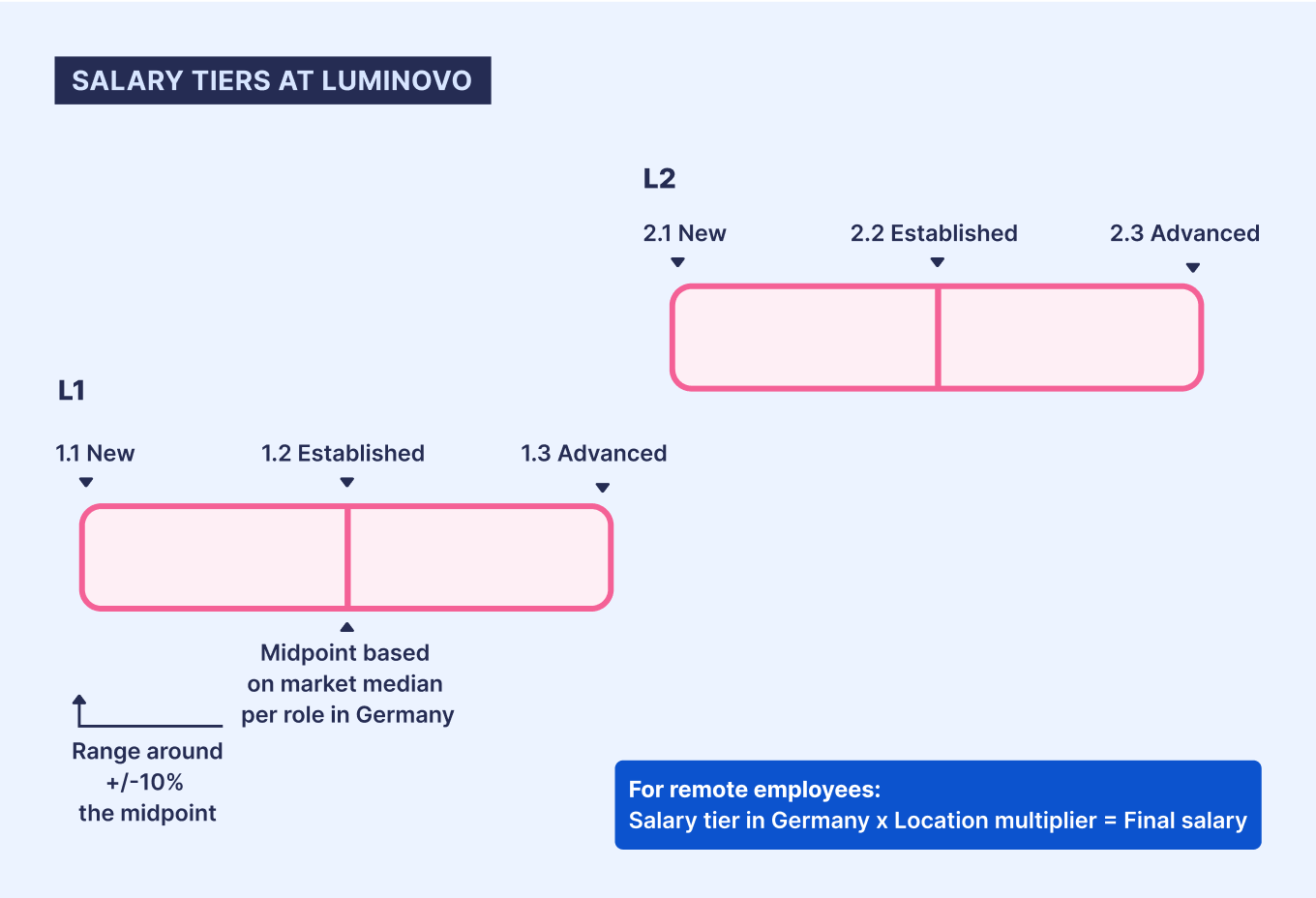
The market median (at or above) is used to inform the ‘midpoint’ of the salary tier for each role – which is the salary given to employees at the .2 established sublevel.
Each salary tier has a range of around 10% either side of the midpoint, with the .1 new sublevel salary around 10% lower than the midpoint and the 1.3 advanced salary around 10% lower than the midpoint.
Germany is the core location for benchmarking due to the company’s HQ in Munich, but salaries are adjusted based on location for remote employees through a ‘cost of labour’ multiplier. Market benchmarking data is analysed for each country to determine an overall multiplier which reflects the overall market rate of compensation in that country compared to Germany.
“As a remote-first company with employees in 35 global locations, it’s important for us to ensure everyone is paid fairly and competitively in the context of their working location – and aligning with local market data is the best way to do that. In the future we’ll likely improve the granularity by differentiating the location multiplier per role, but for our current size a universal multiplier per country is working well.”

People Lead at Luminovo
To maintain consistency and avoid inequities arising, salary negotiation is not allowed at Luminovo for new hires or for performance-related conversations.
New hires are levelled and based on the framework outlined previously, and pay progression is directly aligned to employees demonstrating the skills and capabilities needed to increase their sublevel or level.
🕵️ Ravio POV: Location-based vs location-agnostic salaries, and cost of living vs cost of labour
Whether to adjust employee compensation depending on their location is an important question for companies with offices in multiple locations, or those operating with a hybrid or remote model.
At Ravio, we always recommend a location-based pay model, wherein employee salaries differ depending on their location – just like Luminovo has.
This is because competitive salaries differ significantly across the globe depending on a number of different factors, and this should be reflected in employee pay to ensure compensation is as fair as possible across a whole team.
Many companies opt for a cost of living multiplier to keep things simple, using a source like Numbeo to understand differences per country or city.
However, this isn’t best practice because cost of living is just one of the many factors that goes into differences in compensation across the world, with other factors like supply vs demand for a specific role in a specific location often having much more impact.
The best practice approach is, therefore, to use a global compensation benchmarking provider like Ravio to understand the market rates per location, and adjust salaries in this way – and Luminovo’s ‘cost of labour’ multiplier is one way to approach this whilst maintaining simplicity in a small team.
When hiring for new roles, the range of the salary tier for the associated level is transparently shared within the job advert – and the actual salary offer will reflect their evaluated sublevel, ensuring consistency across the team.
For instance, Luminovo has recently been hiring for a Demand Generation Manager within their marketing team (as of April 2025) – with a salary range of €55,800 to €70,000.
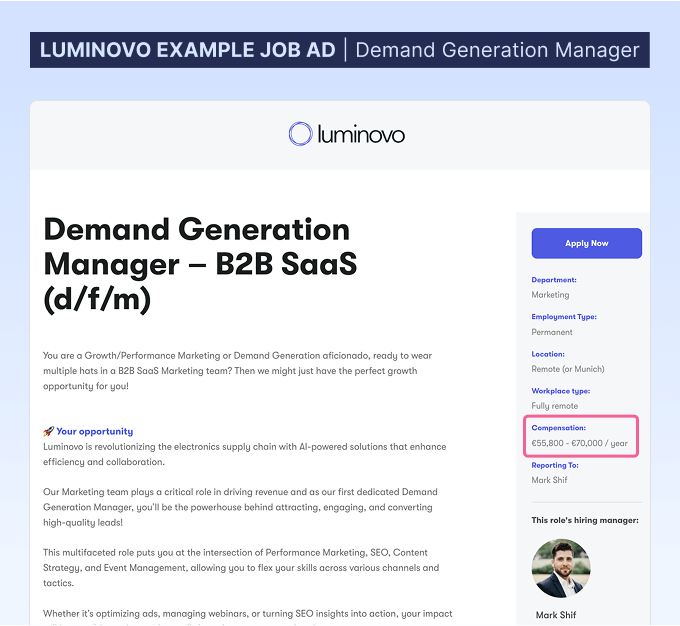
If we look at Ravio’s salary benchmarking data for Performance Marketing roles, we can see that this salary range is roughly in-line (slightly above market) with the market for the P3-P4 levels (data correct as of April 2025).
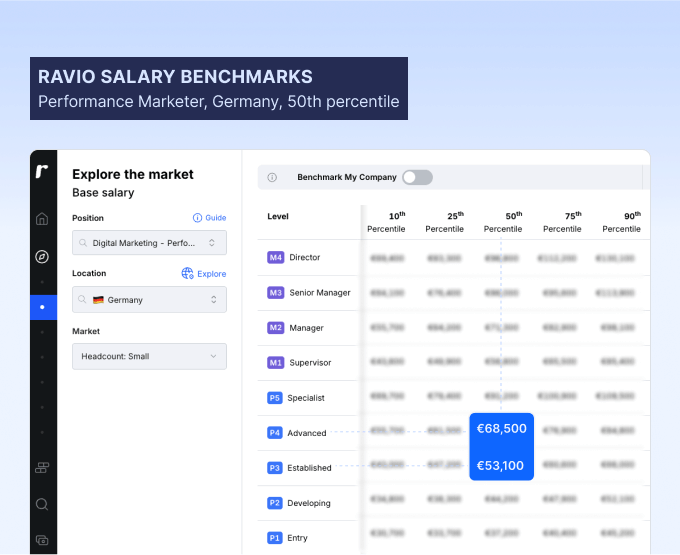
This structured approach of using market data to build pre-defined salary tiers for each job role and level in the company’s taxonomy is vital for ensuring consistent compensation decisions for all employees.
For Hannah, a solid compensation foundation consists of: operating principles (compensation philosophy), a clearly defined level framework, and salary ranges based on market data – and that’s exactly how Luminovo’s approach works today.
"Compensation is both art and science. Market benchmarks give you information on what the companies you compete with for talent pay. How you use that data is the 'art' – based on your operating principles as a company, and the behavioral outcomes you want to drive."

People Lead at Luminovo
Equity compensation at Luminovo
Every employee at Luminovo (affectionately called ‘Luminerds’) is treated as a long-term investor in the company who should benefit for the part they play in business success – and this is achieved through equity compensation in the form of virtual stock options.
Key features of Luminovo's Virtual Stock Option Plan (VSOP) include:
- Vesting schedule: Shares accumulate monthly over 4 years, with a one-year cliff
- No value cap for good leavers: If employees leave on good terms, the value of their vested share options continues to grow even after departure.
- Full acceleration: If the company is sold before all shares are vested, all remaining shares immediately vest to ensure employees can realise the financial upside.
- Low strike price: The strike price is set to the nominal value of 0.001 EUR per stock option to ensure strong financial upside for employees.
Luminerds receive a new hire equity grant as part of their initial job offer, in line with their role and level. They receive an additional grant to reflect performance and progression, as they increase their sublevel or level – to keep equity competitive against the market for their new seniority level.
Other features of Luminovo’s equity compensation include:
- Retention grant: All employees who reach 4 years tenure at Luminovo, and therefore their new hire grant has fully vested, receive an equity refresh grant as an additional incentive for retention.
- Cash-equity trades: Employees have the flexibility to trade base salary for additional equity options after their 1 year cliff is complete.
“I’m really excited about the total compensation data in Ravio’s platform – it gives us an average view on how much equity or OTE companies typically offer per role which is so useful to base decisions on.”

People Lead at Luminovo
🕵️ Ravio POV: How does Luminovo’s equity offering compare to other companies?
It’s typical for tech companies to offer equity compensation as part of total compensation.
However, not all companies offer equity to all employees. It’s common for companies to grant equity only to select roles. Most often this is based on seniority level, wherein only certain job levels receive equity. It’s also common in tech companies for only tech roles to receive equity as a way to make the compensation package more competitive.
As we can see from Ravio’s data, the approach to this varies a lot across countries in Europe.
Luminovo’s HQ is in Germany, so that’s the best comparison to make. We can see that in Germany 37% of tech companies provide equity to all employees – so Luminovo is leading the market in terms of equity compensation, making a competitive and compelling package.
For more insights like this, download our latest Compensation Trends Report >

Employee benefits at Luminovo
Luminovo's employee benefits package reflects their ‘putting people first’ principle, with a strong focus on flexibility, wellbeing, and work-life balance – which are also all elements that make a competitive benefits package today, so support in their high-performance culture too.
Here are a few examples of benefits offered at Luminovo:
- Mental health support: all employees have access to the Bloom mental health platform, supporting healthy work-life balance.
- Remote-first working with flexible hours and a ‘you decide’ approach to productivity
- Visits to the Munich office fully expensed (flights and accommodation) for remote workers
- Team retreats (including an annual ‘LumiWeek’) and co-working weeks to build in-person connection within a remote-first setup
- Home office equipment funded as needed
- Flexible leave, with 28 days paid time off per year and the ability to take as many additional unpaid days as desired
- Childcare subsidies to support parents with childcare costs.
This comprehensive approach to benefits reinforces Luminovo's commitment to creating a positive, flexible work environment that supports their team's personal and professional lives.

Caption: The Luminovo team during their 2024 'LumiWeek'.
Compensation reviews at Luminovo
As we’ve seen, Luminovo has clear and structured level and career progression frameworks – including the sublevel structure which defines how progression works within each job level too.
Compensation adjustments are directly related to job levels at Luminovo, so the only way to increase base salary and equity is for employees to develop and demonstrate the skills and competencies needed to reach the next sublevel or level for their role.
Each employee has a performance review twice a year to keep track of their progress and development, and the timing is defined by each employee’s start date rather than it being a universal review period.
Six months after their start date the employee will receive 360 degree feedback from their colleagues, and one year after their start date they’ll have a 180 degree feedback session with their line manager which is more focused on reviewing their progression and making level and compensation changes as needed to reflect that progression – and this process continues every six months from there on.
Not only does this structured approach bring much-needed clarity to the team in terms of what their career progression and pay progression could look like at Luminovo, it also supports the company’s commitment to building psychological safety for the team.
It’s common for companies to have a large-scale merit cycle process, where employee performance is reviewed and pay increases are made based on the outcomes.
This process can be very stressful for employees, who feel like they need to demonstrate and justify their value. Instead, at Luminovo, the conversations are focused on performance and supporting team members to progress to the next level – and it’s already known that this is how pay increases are achieved.
“Our transparency with the team about our approach to compensation and career progression means that we don’t need to be having discussions about pay with individual employees throughout the year. They aren’t worrying about whether their pay will go up or coming to their line manager with questions and concerns, because they know exactly what the process is, so the focus is on performance and development instead.”

People Lead at Luminovo
Pay transparency and pay equity at Luminovo
As we saw earlier, one of Luminovo’s core operating principles is ‘putting people first’ and this includes a focus on building trust through open, honest, respectful communication.
It therefore makes sense that Luminovo is a company that values transparency – and this shines through in their startup compensation structure too.
Luminovo’s compensation approach is openly communicated to employees to ensure they understand how decisions are made.
The same applies to job candidates when hiring too, with salary ranges transparently listed on job adverts and information in Luminovo’s Candidate Handbook on how those ranges are determined – as well as much more information on the hiring process too.
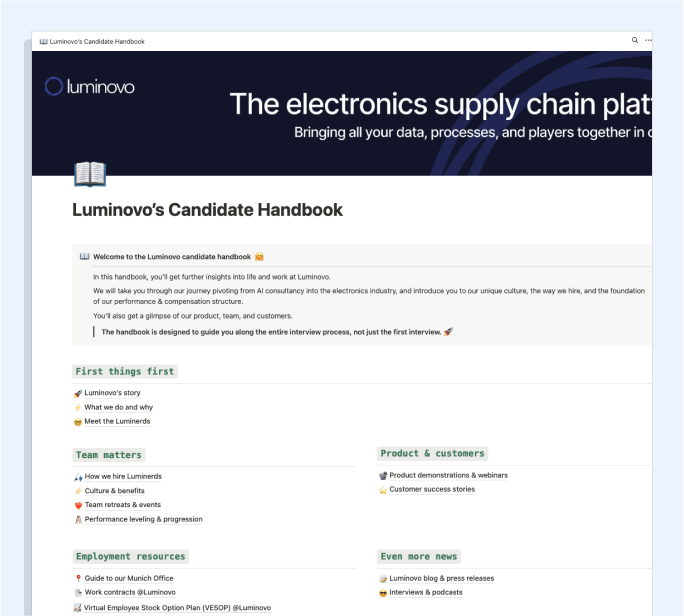
Hannah’s personal belief is that more open conversations about compensation are needed – to build understanding and encourage fairness for employees, but also to support business performance: "open conversations lead to stronger employer branding and more productive hiring conversations."
"Our employees are intelligent and they can handle complex information. Plus, if you are confident about your approach and you have answered all the 'why' questions, then personally I think there's no reason to keep compensation information from an employee. If we are sure about this, why are we keeping it a secret?"

People Lead at Luminovo
🕵️ Ravio POV: Is it always a good thing to share the salary range for a role?
Yes!
Meeting salary expectations is always going to be at the top of the list for a job seeker evaluating whether a new role is a good fit for them – though work/life balance and purposeful work are becoming more and more important too.
When companies don’t list the salary range for roles, they waste everyone’s time in the recruitment process.
The hiring manager ends up with a bunch of candidates who look great on paper, but will never accept a job offer because the role doesn’t meet their salary expectations. The candidate spends time diligently filling out an application form, for a role that doesn’t actually meet their needs.
Plus, with pay transparency laws like the EU Pay Transparency Directive incoming, it will soon be a legal necessity to make job candidates aware of the salary band for a role before they reach the interview stage.
In Luminovo’s case, providing information via the Candidate Handbook to help candidates to understand how salary ranges are determined and how that aligns with the company’s core operating principles and culture, is incredibly valuable for both candidate and employer – it helps to attract team members who align with that thinking.
Increased transparency supports pay equity too through bringing to light any discriminatory practices – which is something that Luminovo is also in support of.
The company’s performance-based hiring approach ensures that the language used within job descriptions is non-discriminatory, focused on skills and objectives rather than types of people.
Plus, the focus on skills also opens up space for applicants from diverse and varied backgrounds too – keeping the focus on capabilities rather than whether candidates have a prestigious degree, which could bias towards privileged backgrounds.
“If you are a young and dynamic startup looking for a ‘young and dynamic team member’ you are putting your company at risk of being sued. If you write performance objectives instead of job requirements and focus on what people do as opposed to what they have or who they are you are much less likely to end up discriminating in your job descriptions.”

Co-founder of Luminovo
The future of compensation at Luminovo
As Luminovo continues to grow, the structures Hannah has put in place for their compensation approach will be essential for scaling the team to meet the company’s goals.
There are a few areas where Hannah is already exploring next steps to continue supporting the team effectively – including adding additional levels to their level framework, and increasing the granularity of their location multiplier by accounting for pay differences per role in each location.
But, by using the company’s operating principles as the foundation, emphasising transparency, market competitiveness, and a structured yet flexible framework for progression, Luminovo already has a compensation strategy that can scale with the team.
If you’re looking to learn from Luminovo's approach, here are a few key takeaways:
- Align compensation philosophy with company values and culture
- Create a clear and transparent level framework that defines skillsets, capabilities, and progression pathways
- Use market data to ensure competitive pay – but apply your company's principles to that data
- Balance structure and consistency with flexibility and employee choice.
